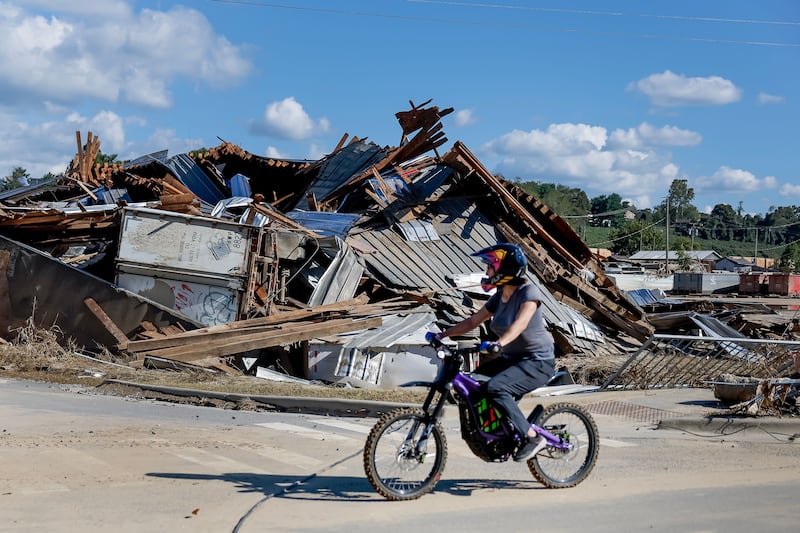As historic floodwaters unleashed by Hurricane Helene recede across the US southeast, the region faces a humanitarian, economic and ecological crisis of staggering scope, with effects likely to last years.
Cotton crops on the verge of harvest have been flattened. Sewage and industrial chemicals have poured into swollen rivers. Key pieces of the power grid have been destroyed. Chicken flocks in some of the country’s largest poultry-producing states have drowned. Mines that produce high-quality quartz for computer chips remain closed.
And the toll on human lives keeps rising, with more than 180 confirmed dead across six states and countless others displaced. The federal government reported 29 shelters open, with more than 1,000 occupants.
The storm dumped more than 35cm of rain over three days on to western North Carolina, transforming mountainsides into mudslides and creeks into torrents.
“It’s horrendous,” said Aaron Smith, who said he was trying to figure out where to take his family after his home in the hamlet of Bat Cave was destroyed. “I don’t see anything to go back to.”
Asheville, the largest city in the flood-hit region, had in recent years developed a reputation as a climate refuge, drawing residents from more storm-prone areas.
Among the new arrivals: the federal government, which moved its national data centre for environmental records there in 2015. The facility was knocked offline by Helene.
In Georgia, vice-president Kamala Harris surveyed the damage on Wednesday in Augusta, where people were contemplating how much of their lives had been unmade by Helene.
“I am here to personally take a look at the devastation,” said Ms Harris after receiving a briefing from emergency response leaders. “It’s particularly devastating in terms of loss of life that this community has experienced, the loss of normalcy, and the loss of critical resources.”
The Augusta area has received less national attention than given to western North Carolina, with its washed-out roads and severe flooding, but most people in the Georgia city had been without power since Friday morning. Some had been unable to leave their homes for days, as tall poplar, live oak and cedar trees littered the streets. Uprooted trees lined every main road. Trees along Augusta’s downtown strip lay on their sides, torn out of the sidewalk straight through four inches of concrete.
The region has experienced devastating hurricanes before. But the sweep of Helene’s damage — much of it occurring far from shore, in mountain towns and inland fields — took many by surprise. The crop losses alone could trigger $7 billion (€6.3 billion) in insurance payouts, a US department of agriculture official estimated.
“The future of hundreds of agricultural operations across Georgia is uncertain,” said the state’s agriculture commissioner Tyler Harper in a letter to its congressional delegation this week. The storm “could not have come at a worse time for our farmers and producers, who are already faced with record-setting drops in net farm income caused by inflation, high input costs, labour shortages, global competition and low commodity prices”.
As climate change roils weather patterns worldwide, exceptionally hot ocean temperatures are unleashing powerful, deadly hurricanes. Helene followed the destruction of Hurricanes Beryl and Debby earlier this year.

Helene crashed ashore late last Thursday in Florida with 225km/h winds (140mph) before ploughing a path north into the Appalachian Mountains. Even before it reached shore, moisture from the storm soaked the region, saturating the earth and priming several states for flooding.
Parts of the southeast were still struggling to reopen roads and reconnect power. At its peak, the storm knocked out electricity to more than four million homes and businesses and while utilities were able to restore service to many customers quickly, progress has been painfully slow in the hard-hit mountains and foothills. Georgia Power called Helene the most destructive hurricane in the company’s history, damaging 1,200 of its transformers — devices that convert the high-voltage power flowing across transmission lines into the lower voltage used in homes.
Even as they race to reconnect communities and house the displaced, states are tallying up Helene’s environmental damage. Inundated wastewater systems released millions of gallons of sewage, while a Florida phosphate plant on the banks of Tampa Bay released hundreds of pounds of ammonia. Hundreds of spills have been reported to state environmental officials from Florida to North Carolina in the wake of the storm, which dumped more than 30cm (12in) of rain over industrial areas, paper mills and factories.
“We are seeing just catastrophic flooding,” said Gray Jernigan, general counsel for environmental group MountainTrue, who watched the devastation first-hand as the French Broad river in Asheville, North Carolina burst its banks, flooding the city’s river arts district. “We are seeing chemicals, gas and oil spill and fuel tanks flowing into the river. Industrial sites are spilling into the river.”

The site of a coal-fired power plant and retired nuclear plant owned by Duke was also swamped with floodwaters after experiencing a storm surge of as much as 3.6m (12ft), said the company on September 27th in a filing with the Florida department of environmental protection. A wastewater pond at the facility “was observed overflowing to the ground due to the surge”, according to the report. The city of Tampa, meanwhile, released 8.5 million gallons of sewage alone after storm surges overwhelmed the system, said city spokeswoman Kathlyn Fitzpatrick.
“Most of it went into the bay,” said Ms Fitzpatrick. “There is really nothing we can do about that.”
Flooding across the region has started to recede. By Tuesday afternoon, the French Broad river in Asheville was no longer at flood stage. The river crested at 8.1m (above 24½ft) in the city, a full 46cm (18in) higher than the previous record set in 1916.
“Unfortunately, this one is going to be the new big one,” said Clay Chaney, a meteorologist for the national weather service in Greer, South Carolina. — Bloomberg/Agencies




















